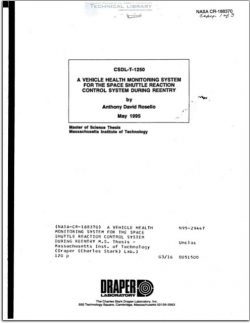NASA-CR-188370

- Version
- 226 Downloads
- 4.37 MB File Size
- 1 File Count
- August 16, 2016 Create Date
- August 16, 2016 Last Updated
A Vehicle Health Monitoring System for the Space Shuttle Reaction Control System During Reentry

Abstract
A general two tier framework for Vehicle Health Monitoring of Guidance
Navigation and Control (GN&C) system actuators, effectors, and propulsion
devices is presented. In this context, a top level monitor that estimates jet thrust
is designed for the Space Shuttle Reaction Control System (RCS) during the
reentry phase of flight. Issues of importance for the use of estimation
technologies in Vehicle Health Monitoring are investigated and quantified for the
Shuttle RCS demonstration application. These issues include rate of
convergence, robustness to unmodeled dynamics, sensor quality, sensor data
rates, and information recording objectives. Closed loop simulations indicate
that a Kalman filter design is sensitive to modeling error and robust estimators
may reduce 'this sensitivity. Jet plume interaction with the aerodynamic
flowfield is shown to be a significant effect adversely impacting the ability to
accurately estimate thrust.
1.0 Introduction
A primary objective for the development of future aerospace vehicles
is the significant reduction of life cycle costs. To achieve this objective, more
vehicle autonomy will be required with less emphasis on ground operations .
and maintenance. Vehicle Health Management is a key technology that will
help aerospace systems meet these higher expectations, particularly in
reduction of operations cost. Vehicle Health Management systems, which
include Vehicle Health Monitoring algorithms, will allow the autonomous
observation of vehicle subsystems. while in their normal operating
environment. Vehicle Health Management systems include all components
needed to characterize system performance including: sensors, data pathways,
processors, and monitoring algorithms. Figure (1.0-1) illustrates the
relationship between the management and monitoring systems. For the
remainder of the text, VHM will refer to Vehicle Health Monitoring. The
information provided by a VHM system can be used to identify off nominal
performance, and possibly reconfigure to correct for degraded or failed
performance. Off-line, the recorded VHM data may subsequently be used to
warn of impending failure, better schedule and perform preventive
maintenance, and detect problems that would otherwise remain unnoticed,
until a later flight. ‘
The VHM system envisioned here will be designed to monitor
performance of Guidance, Navigation, and Control (GN&C) system actuators,
effectors, and propulsion devices using a two tier hierarchy. The top level, or
global monitor, will determine whether the actuator or effector produced the
expected result by monitoring the vehicle’s dynamic response to known
inputs. The top level of the monitor will be a dynamics based estimation
algorithm which will identify off-nominal sensor or effector performance.
After a particular sensor or effector has been identified, the lower level, or
local, monitoring system isolates the problem further. The lower level,
possibly an expert based system, fuzzy logic or learning system, will fuse the
general information from the global level and conduct a search of finer
granularity for the component causing the problem.
The VHM system will function during all phases of vehicle operation
and store its data in-flight. Information recorded during vehicle operation
| File | Action |
|---|---|
| NASA-CR-188370 A Vehicle Health Monitoring System for the Space Shuttle Reaction Control System During Reentry.pdf | Download |

Comment On This Post